| کد مقاله | کد نشریه | سال انتشار | مقاله انگلیسی | نسخه تمام متن |
|---|---|---|---|---|
| 4508915 | 1624467 | 2014 | 10 صفحه PDF | دانلود رایگان |
• The effect of sowing palisade grass into soybean crops at different stages was evaluated.
• We evaluated the overall revenue of the crop–livestock integration (CLI).
• Interseeding palisade grass up to 30 DAE of soybean did not affect soybean yield.
• Intercropping resulted in 1.6 times more revenue than soybean alone.
Integrated no-till crop and livestock production systems may help rejuvenate degraded pastures, increase land use efficiency (LUE), and increase enterprise revenue. Our objectives were to evaluate: (1) planting date effects on seed yield and nutrient concentration of an early-maturing, no-till system (NTS) soybean (Glycine max) when intercropped with palisade grass (Brachiaria brizantha); (2) dry matter production and protein concentration of the grass pasture after soybean harvest; and (3) overall revenue and LUE for the intercrop system. Experiments were performed during two growing seasons in Botucatu, Brazil using a randomized complete block experimental design. When palisade grass and soybean were sown simultaneously, soybean yield averaged 3.28 Mg ha−1. Similar seed yields were observed when palisade grass was planted either 30 d after soybean emergence (DAE) (3.29 Mg ha−1) or at the soybean reproductive stage R6 (full seed) (3.50 Mg ha−1). Monocrop soybean yield averaged 3.50 Mg ha−1. First cut dry matter forage production was greater when palisade grass was sown at the same time as soybean or 30 DAE of soybean. This indicates that interseeding palisade grass with soybean does not significantly affect soybean nutrition or yield. Intercropping did increase LUE and resulted in 1.6 times more revenue than soybean alone. However, sowing palisade grass at the soybean reproductive stage R6 (full seed) significantly reduced the forage yield compared to early planting.
Journal: European Journal of Agronomy - Volume 58, August 2014, Pages 53–62
